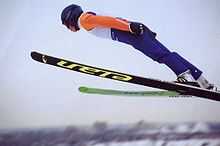V-style
The V-style of ski jumping was created by Mirosław Graf, a Polish ski jumper from Szklarska Poręba.[1] As early as 1969 Graf discovered the style as a kid, but later his colleagues were laughing at his jumps.
Graf was fully aware that the "V" style was better than the previous one, because his jumps became considerably longer. In the 80s, this style of jumping was considered inappropriate by the jury, and although it enabled very long jumps, judges awarded poor marks to those who used the style.
It was only recognized by the judges in the early 90s after wins and high rankings by Jan Boklöv from Sweden and Jiří Malec from Czechoslovakia despite low marks. Already in early 90s it was the most dominant style, not any more penalized as it had proven to be both safer and better than the previous style.
The style is a modification of the Daescher technique. In this technique the skis are held during the jump alongside the upper torso in a V-like shape. In the Daescher technique, the skis were kept parallel to each other. This new technique increases the ski jumping distance by 10 percent.
The style is sometimes called Graf-Boklov,[2] but western journalists sometimes marginalize Polish inventor Graf or Czech contemporary and pioneer on international stage Malec and credit Boklöv alone with V-style.
Aerodynamics has become increasingly important in modern ski jumping, with recent rules addressing the regulation of ski jumping suits. This follows a period when loopholes in the rules seemed to favor skinny jumpers in stiff, airfoil-like suits. This technique is part of this trend.
References
This article about ski jumping is a stub. You can help by expanding it
External links
| Wikimedia Commons has media related to V-style. |
